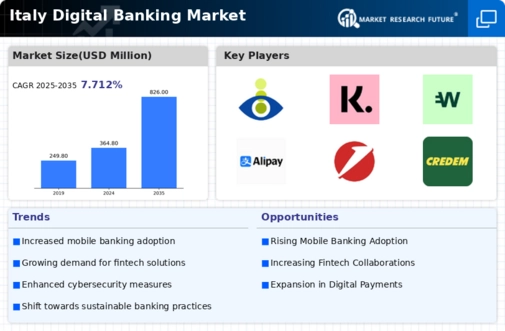Increased Focus on Financial Inclusion
Financial inclusion remains a pivotal driver for the digital banking market in Italy. The government and various financial institutions are actively working to provide banking services to underserved populations, including low-income individuals and small businesses. As of 2025, approximately 15% of the Italian population remains unbanked or underbanked, highlighting a significant opportunity for digital banking solutions. Initiatives aimed at improving access to banking services, such as mobile banking apps and low-cost digital accounts, are gaining traction. This focus on financial inclusion not only expands the customer base for digital banks but also contributes to the overall growth of the market, as more individuals gain access to essential financial services.
Growing Demand for Contactless Payments
The digital banking market in Italy is experiencing a notable surge in demand for contactless payment solutions. This trend is driven by consumer preferences for convenience and speed in transactions. As of 2025, approximately 60% of all card transactions in Italy are contactless, reflecting a significant shift in payment behavior. The increasing adoption of Near Field Communication (NFC) technology among banks and financial institutions further supports this growth. Additionally, the rise of mobile wallets and payment apps has contributed to the expansion of contactless payment options. This growing demand is likely to propel the digital banking market, as institutions invest in enhancing their payment infrastructures to meet consumer expectations and improve user experience.
Rising Consumer Awareness and Digital Literacy
Consumer awareness and digital literacy are increasingly becoming vital drivers of the digital banking market in Italy. As more individuals become familiar with digital banking tools and services, their willingness to adopt these solutions grows. Educational initiatives and marketing campaigns by banks are playing a crucial role in enhancing digital literacy among consumers. By 2025, it is estimated that around 70% of the Italian population will have a basic understanding of digital banking services, which is expected to boost adoption rates. This rising awareness not only encourages more users to engage with digital banking platforms but also fosters a competitive environment where banks strive to improve their offerings. Consequently, this trend is likely to contribute positively to the growth trajectory of the digital banking market.
Regulatory Support for Digital Banking Innovations
The digital banking market in Italy benefits from a favorable regulatory environment that encourages innovation and competition. The Italian government, along with the European Union, has implemented various initiatives aimed at fostering digital transformation in the financial sector. For instance, the introduction of the PSD2 directive has opened up the market to new players, promoting the development of fintech solutions. This regulatory support is crucial for the growth of the digital banking market, as it enables traditional banks and new entrants to collaborate and innovate. As a result, the market is likely to see an influx of new services and products that cater to the evolving needs of consumers, thereby enhancing overall market dynamics.
Technological Advancements in Banking Infrastructure
The digital banking market in Italy is significantly influenced by ongoing technological advancements in banking infrastructure. Innovations such as cloud computing, blockchain technology, and advanced data analytics are reshaping how banks operate and deliver services. As institutions invest in modernizing their IT systems, they are better equipped to offer seamless and efficient digital banking experiences. For instance, the integration of blockchain technology is enhancing transaction security and transparency, which is crucial for building consumer trust. By 2025, it is anticipated that over 40% of banks in Italy will have adopted cloud-based solutions, further streamlining operations and improving service delivery. These technological advancements are likely to drive competition and innovation within the digital banking market.





















Leave a Comment